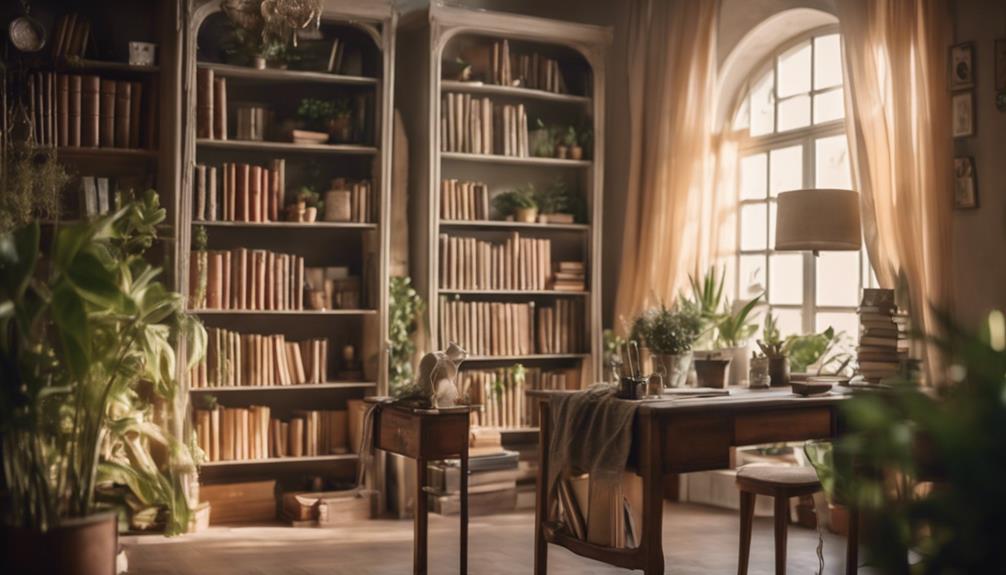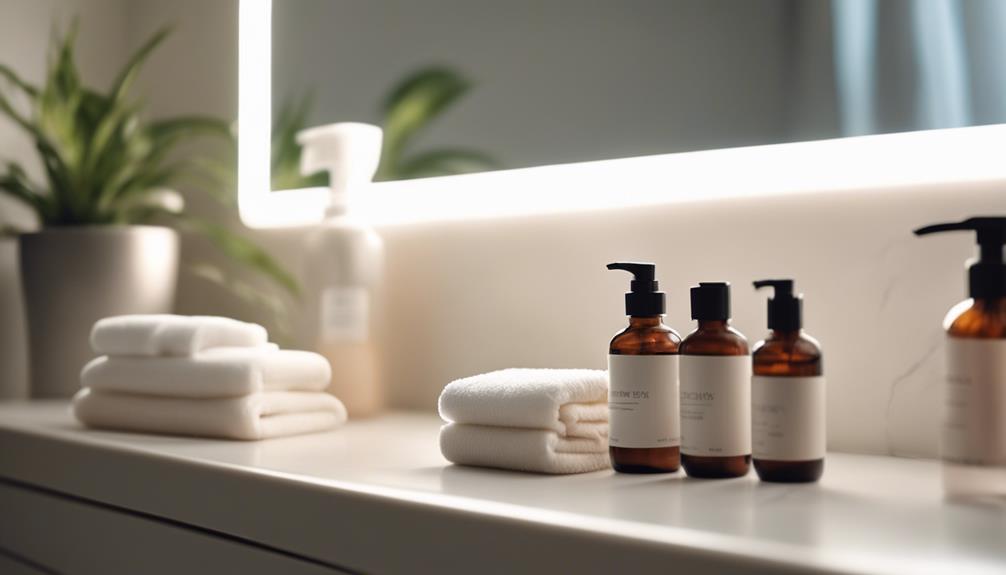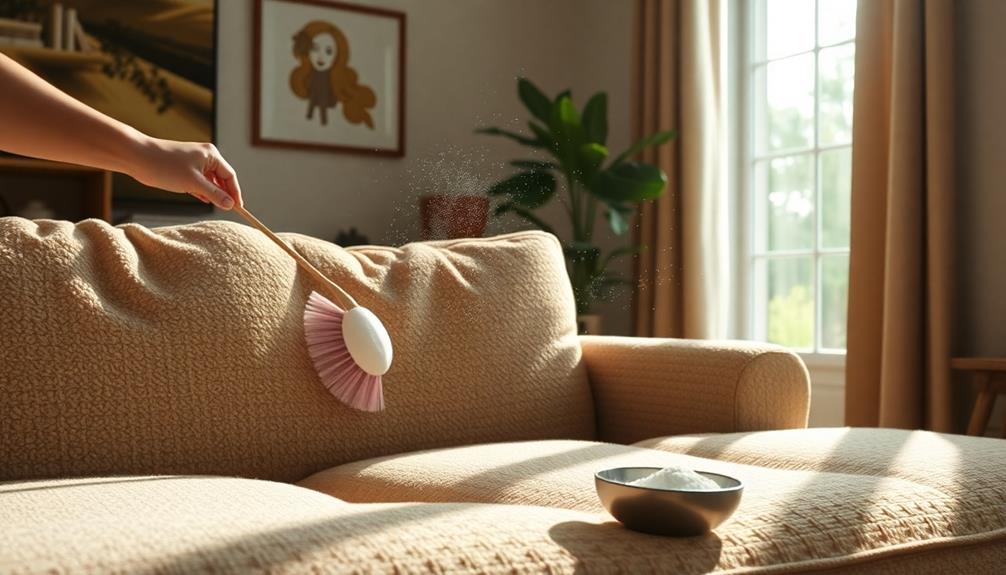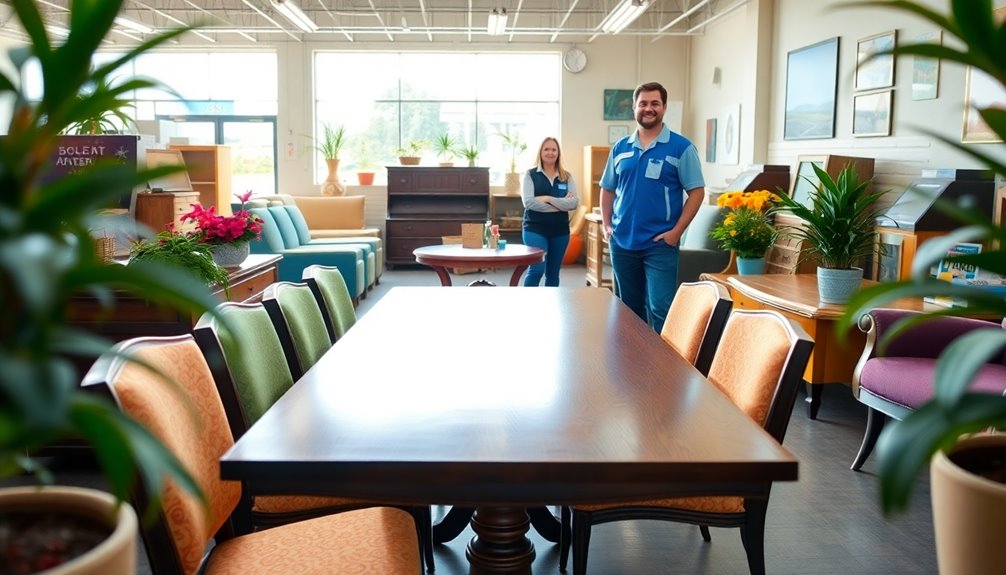Light Academia room decor will turn your space into a bright and inviting retreat that impresses everyone with its charm. Begin by selecting soft, muted tones and natural fabrics to establish a cozy atmosphere. Integrate vintage pieces like antique bookcases and brass candlestick holders for a sophisticated touch. Remember to incorporate warm lighting through stylish table lamps or soft string lights to maintain a welcoming ambiance. Adding personal elements, such as framed botanical illustrations or a vintage tea set, will elevate your decor. If you are looking for more tips and ideas to perfect your Light Academia aesthetic, there is plenty more to explore!
Key Elements

When you're creating a Light Academia space, focus on your color scheme, materials, and textures.
Soft, muted tones paired with natural fabrics can really set the mood.
Incorporating layers and patterns will add depth and warmth to your decor, making it feel inviting and scholarly.
Color Scheme
The Light Academia color scheme combines soft, muted tones like creams and beiges with pastel accents, creating an inviting and airy atmosphere that feels both cozy and scholarly. This color palette emphasizes natural hues, allowing you to cultivate a serene environment. You can incorporate shades like powder blue and baby pink to add gentle pops of color without overwhelming the space.
When selecting paint for your walls and ceilings, opt for lighter tones to amplify the light academia aesthetic. This choice fosters a warm, welcoming vibe. To maintain elegance, introduce darker shades in your furniture or as accent pieces, ensuring a balanced look. Rich fabrics and floral patterns can also lend warmth and character to your decor, enhancing the overall charm of the room.
Consider using decorative elements like elaborate wallpaper featuring vintage-inspired designs or delicate floral motifs. These details will further enrich your color scheme, making your space feel sophisticated yet comfortable.
Materials
Embrace light, airy materials like wood, cotton, and linen to craft a carefree and inviting atmosphere in your Light Academia room decor. These natural materials effortlessly enhance the aesthetic, allowing light colors to reflect and brighten your space. Opt for wooden furniture that showcases clean lines and a simple design, creating a sense of openness and tranquility.
Textiles play an essential role in this decor style, so consider incorporating soft furnishings like lace drapes and vintage floral bed sheets. These elements not only add comfort but also bring a touch of romance to your room. You can mix and match iconic patterns like plaids and gingham, which introduce sophistication while maintaining a casual vibe.
Don't shy away from layering different materials to create depth and warmth. Combine rich fabrics with your lighter textiles for a cozy, lived-in feel that invites you to relax and unwind.
Textures
Textures bring your Light Academia room to life, creating a cozy and inviting environment that encourages relaxation and creativity. To achieve this aesthetic, focus on using light colors and soft finishes that embody an airy, carefree atmosphere. Materials like cotton and linen are perfect for curtains, cushions, and throws, enhancing the overall comfort of your space.
Incorporating iconic patterns such as dainty florals, gingham, and plaids adds depth and sophistication to the decor. Layering different fabrics, like floral prints and ruffled comforters, not only enhances the ethereal quality of your room but also makes it feel warm and welcoming. Vintage-inspired textiles, including lace or sheer drapes, can contribute an elegant touch, reinforcing the Light Academia theme.
Don't be afraid to mix textures; the combination of smooth linens with softer, more tactile materials creates visual interest and invites touch. Aim for a balance that feels lived-in yet refined.
With thoughtful layering and a focus on light colors and soft finishes, your Light Academia room will radiate charm, encouraging everyone to relax and appreciate the beauty around them.
Essential Fixtures and Furniture
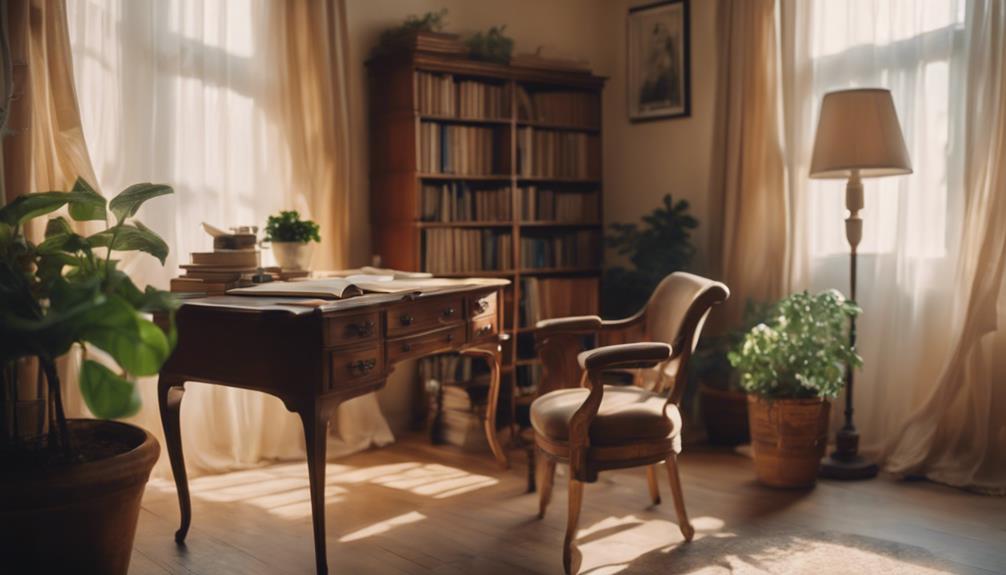
To create a true Light Academia vibe, you'll want to focus on essential fixtures and furniture that reflect the aesthetic.
A vintage leather armchair offers a cozy spot for reading, while an antique wooden bookcase showcases your favorite literary treasures.
Don't forget a vintage globe bar cart to add a touch of charm and sophistication to your space.
Vintage Leather Armchair
A vintage leather armchair brings sophistication and warmth to your Light Academia space, perfectly enhancing the cozy, scholarly aesthetic. This piece not only invites relaxation but also creates an ideal reading nook where you can immerse yourself in vintage books, fostering a sense of contemplation. The rich texture and classic design of the armchair complement the old world charm that defines Light Academia interiors.
When choosing your vintage leather armchair, pay attention to features like intricate stitching and tufted designs. These details evoke a sense of history and authenticity, making your decor even more inviting. The deep, muted tones of leather harmonize beautifully with lighter wall colors and floral accents, allowing your armchair to stand out as a striking focal point.
Incorporating this essential fixture into your space elevates the maximalist elegance that Light Academia embodies. It's not just functional seating; it's a statement piece that reflects your personal style and appreciation for timeless design.
Antique Wooden Bookcase
An antique wooden bookcase serves as a cornerstone in Light Academia decor, beautifully showcasing your collection of vintage books and cherished decorative items. Opting for a bookcase made from rich woods like mahogany or oak instantly enhances the warmth and coziness of your space. The intricate woodwork and architectural elements, such as crown molding and carved details, add character and historical authenticity, aligning perfectly with the vintage-inspired aesthetic of Light Academia.
When you style your antique wooden bookcase, consider incorporating soft lighting, lush plants, and personal trinkets to create an inviting atmosphere reminiscent of classic libraries and studies. This arrangement not only highlights your curated collection but also transforms your room into a scholarly haven.
Position your bookcase as a focal point, drawing the eye and sparking conversation. You'll find that it not only serves a practical purpose but also elevates the overall ambiance of your space.
With the right styling, your antique wooden bookcase becomes more than just furniture; it's a reflection of your love for knowledge, beauty, and the timeless elegance that defines Light Academia decor.
Vintage Globe Bar Cart
Embracing the charm of a vintage globe bar cart adds both functionality and character to your Light Academia-inspired space, making it a perfect blend of style and nostalgia. This unique piece serves as a functional furniture item while doubling as an eye-catching decorative element. The intricate designs and rich woods typically found in these carts harmonize beautifully with the muted jewel tones and nature-inspired colors prevalent in Light Academia decor.
A vintage globe bar cart allows you to creatively store spirits and glassware, all while showcasing curated collections of books and other decorative elements. This enhances the cozy, scholarly atmosphere you're aiming for. Whether you place it in your living room as a focal point or as a stylish accent in your study or dining area, its versatility shines through.
To elevate your decor, consider adding personal touches like vintage cocktail shakers or antique glassware on the cart. These elements not only reflect your individual style and interests but also deepen the nostalgic vibe of your space, perfectly aligning with the Light Academia theme.
Lighting Ideas
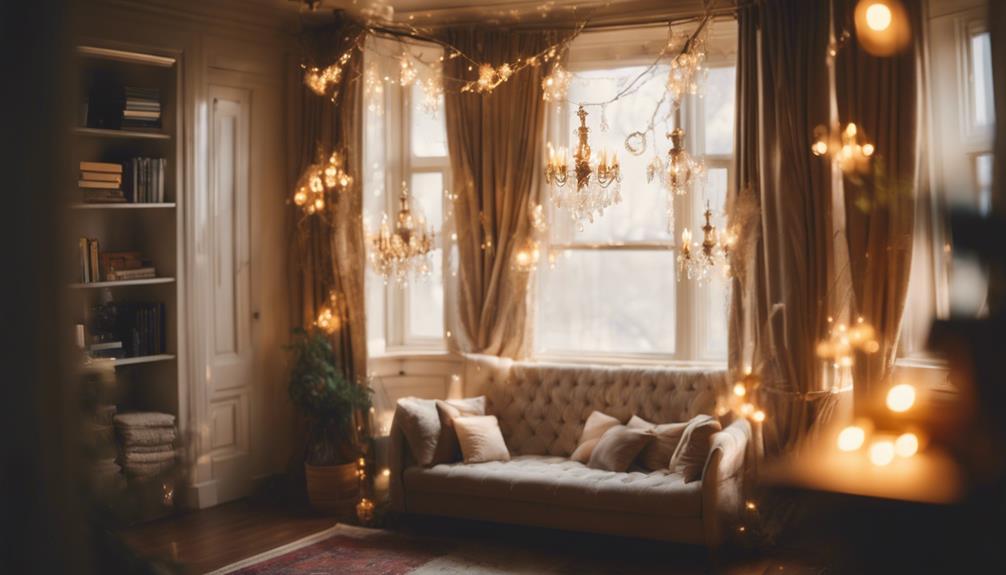
When it comes to lighting ideas for your Light Academia space, you'll want to focus on creating a warm and inviting atmosphere.
Think about incorporating chic brass table lamps and vintage crystal chandeliers to add elegance, while soft Edison bulb string lights can bring a whimsical touch.
Don't forget the importance of natural light—large windows can enhance the overall aesthetic and keep your room feeling airy and bright.
Chic Brass Table Lamps
Chic brass table lamps effortlessly elevate your Light Academia decor, infusing elegance and warmth into every corner of your space. Their warm metallic finish complements the vintage and scholarly vibe, making them a perfect addition to your study or reading nook. These lamps provide soft, ambient lighting that enhances the cozy atmosphere typical of Light Academia, inviting you to immerse yourself in your favorite books.
When selecting chic brass table lamps, look for designs featuring intricate detailing or vintage-inspired shapes. This attention to detail aligns beautifully with the aesthetic you're aiming for. To add depth and personality, consider pairing your brass lamps with floral or patterned shades. This combination creates a lovely contrast while maintaining the light, airy feel of your decor.
Not only do these lamps serve a practical purpose, but they also act as decorative focal points, embodying the maximalist approach characteristic of Light Academia interior design. So, bring in those chic brass table lamps and watch as they transform your space into a warm, inviting sanctuary that reflects your unique style and passion for knowledge.
Vintage Crystal Chandeliers
Vintage crystal chandeliers become stunning focal points in your Light Academia decor, adding elegance and a touch of glamour to any room with their intricate designs and sparkling reflections. These chandeliers often feature a beautiful blend of glass crystals and ornate metalwork, creating a timeless aesthetic that perfectly complements the vintage-inspired elements of Light Academia.
When you choose a vintage crystal chandelier, consider the size and scale of your space. You want it to enhance your room without overwhelming it.
Ideal placements include above dining areas or in cozy reading nooks, where their beauty can be fully appreciated. The soft, warm light emitted by these chandeliers not only brightens your space but also fosters an inviting atmosphere, promoting relaxation and creativity—a key aspect of the Light Academia philosophy.
Soft Edison Bulb String Lights
Soft Edison bulb string lights instantly transform your space, casting a warm, inviting glow that perfectly embodies the cozy essence of Light Academia decor. These lights aren't only visually appealing but also practical, allowing you to enhance your atmosphere without compromising on style.
You can easily drape soft Edison bulb string lights along walls, bookshelves, or around vintage furniture, creating a whimsical effect that captivates anyone who enters. Their vintage-inspired design adds a nostalgic touch, blending seamlessly with the classic and timeless elements of Light Academia.
Moreover, these string lights are energy-efficient and typically use LED technology, ensuring minimal environmental impact while providing ample illumination. Whether you're looking to create a relaxing ambiance in your bedroom, study area, or living space, these lights are a versatile decorative choice that suits any Light Academia-inspired room.
Natural Light Through Large Windows
Large windows flood your space with natural light, enhancing the airy and inviting atmosphere that defines Light Academia decor. To make the most of this illumination, consider using sheer or lace drapes. These options soften the incoming light while maintaining a breezy feel, perfectly complementing the muted jewel tones typical of a light academia room.
To further amplify natural light, incorporate reflective surfaces such as mirrors or glass furniture. These elements can create a sense of spaciousness, making your room feel more expansive and bright. It's also wise to choose window treatments like Roman shades or light-filtering blinds. These allow you to control the brightness, ensuring a cozy ambiance throughout the day.
Positioning your furniture near windows can enhance the effect of natural light even more. Create inviting reading nooks or study areas that inspire relaxation and creativity. By thoughtfully arranging your space, you'll not only embrace the beauty of light academia but also cultivate an environment that encourages productivity and peace.
Let the natural light in, and watch your light academia room transform into a bright, inspiring haven.
Decorative Elements
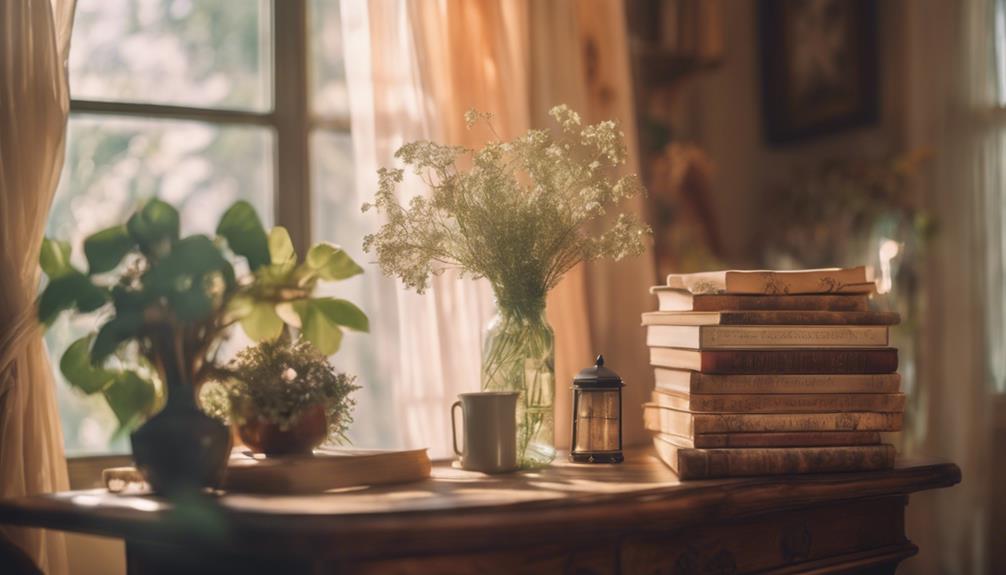
To truly capture the essence of Light Academia, you'll want to incorporate decorative elements that resonate with vintage charm.
Consider adding antique brass candlestick holders for soft, romantic lighting, a vintage porcelain tea set for elegant gatherings, and framed botanical illustrations to bring nature indoors.
These pieces not only enhance the aesthetic but also reflect your personal style and appreciation for the past.
Antique Brass Candlestick Holders
Antique brass candlestick holders bring vintage elegance into your Light Academia decor, casting a warm glow that beautifully enhances the atmosphere. These stunning pieces often showcase intricate designs, like filigree or floral patterns, which perfectly align with the maximalist approach of Light Academia interiors.
When you incorporate these candle holders, you'll find they create an inviting ambiance, especially when paired with tapered candles in muted jewel tones or soft pastels. This combination not only adds depth to your space but also sets the ideal mood for cozy reading or studying sessions.
Antique brass finishes don't just illuminate your room; they evoke a sense of nostalgia and intellectual charm that resonates with the Light Academia aesthetic. Use them as focal points on bookshelves, mantels, or dining tables, and watch how they elevate your overall decor.
With antique brass candlestick holders, you're not just adding decorative elements; you're enhancing the very essence of your space, making it a haven of warmth and sophistication. Embrace these timeless treasures and let them transform your Light Academia-inspired room into a fascinating sanctuary.
Vintage Porcelain Tea Set
Incorporating a vintage porcelain tea set into your Light Academia decor not only enhances the elegance of your space but also adds a charming historical narrative that complements the overall aesthetic. These tea sets often feature intricate floral patterns and soft pastel colors, perfectly aligning with the muted tones typical of Light Academia.
Displaying a vintage porcelain tea set on a decorative tray or inside a glass cabinet creates a stunning focal point, enriching the scholarly and refined atmosphere of your room. Each piece evokes a sense of history and craftsmanship that resonates with the Light Academia appreciation for the past.
You don't have to spend a fortune to find a vintage tea set; thrift stores and antique shops are treasure troves for budget-friendly options. By sourcing your set from these places, you not only infuse your decor with character and charm but also celebrate sustainability and the joy of unique finds.
Framed Botanical Illustrations
Framed botanical illustrations bring a touch of nature-inspired elegance to your Light Academia decor, enhancing the overall aesthetic with their intricate details and muted colors. These illustrations perfectly align with the soft, dreamy tones characteristic of the Light Academia palette. Incorporating them as a decorative element not only beautifies your space but also infuses it with a sense of nostalgia and appreciation for the natural world.
To create a striking visual impact, consider displaying your framed botanical illustrations in vintage or ornate frames. This approach can help you achieve a mesmerizing gallery wall effect that showcases your personal style and intellectual interests. When placed alongside other vintage-inspired decor, like antique furniture and soft textiles, these illustrations contribute to a cohesive and inviting atmosphere.
Moreover, the delicate designs found in botanical art evoke a sense of tranquility, making your room feel serene and scholarly. Whether you choose to hang them in your study, bedroom, or living area, framed botanical illustrations serve as a reminder of nature's beauty and the intellectual pursuits central to the Light Academia aesthetic.
Embrace this decorative element to truly elevate your space!
Flooring
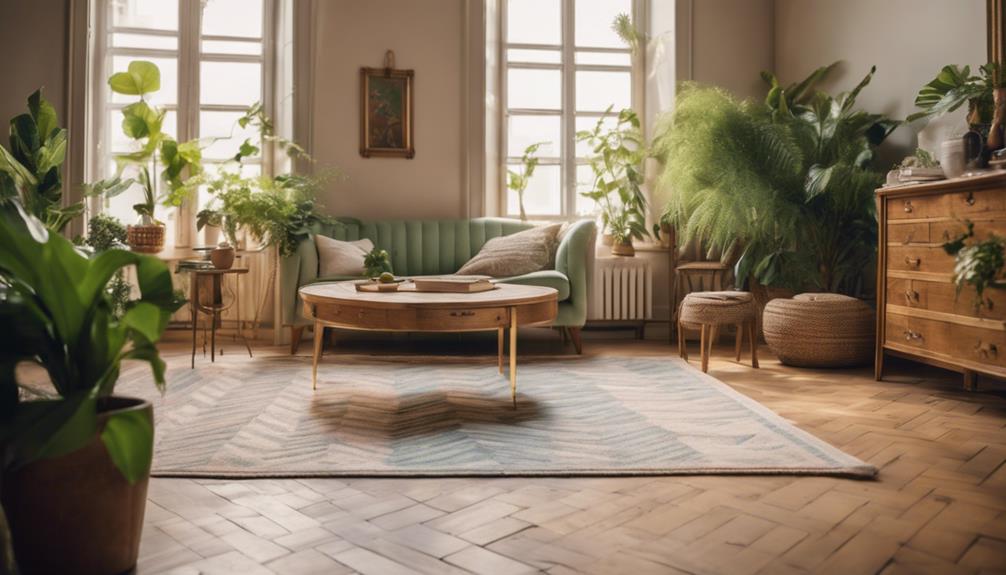
When choosing flooring for your Light Academia space, consider options like distressed oak hardwood for that timeless charm.
Soft beige carpet tiles can add warmth and comfort, making your room feel inviting.
If you're after something unique, herringbone-patterned parquet flooring can elevate your aesthetic with a touch of elegance.
Distressed Oak Hardwood Flooring
Distressed oak hardwood flooring often brings a rustic charm to your space, thanks to its weathered appearance that enhances warmth and character. This flooring type features unique textures achieved through techniques like scraping, hand-sanding, or wire-brushing, giving it a distinctive look that feels both inviting and stylish.
Not only does distressed oak offer aesthetic appeal, but it also boasts durability and longevity, making it ideal for high-traffic areas. Its warm tones and natural grain patterns seamlessly complement the soft, muted palettes of Light Academia decor, often incorporating creams, beiges, and pastel accents. This synergy allows you to create a cohesive and inviting atmosphere that resonates with vintage-inspired elements.
Maintaining distressed oak hardwood flooring is straightforward; regular cleaning and periodic refinishing guarantee it remains a stunning centerpiece in your home for years to come. By choosing this flooring option, you'll not only enhance the character of your space but also embrace the timeless elegance that defines Light Academia.
Let the unique charm of distressed oak flooring elevate your decor and create a welcoming environment that impresses everyone who visits.
Soft Beige Carpet Tiles
Soft beige carpet tiles offer a cozy and inviting foundation that perfectly complements the Light Academia aesthetic. Their warm, neutral hue enhances the overall brightness of your space, creating an open and airy feel that aligns beautifully with the lightness emphasized in this design style. When you incorporate these tiles into your rooms, whether it's a bedroom, study, or living area, you'll instantly enhance the cozy atmosphere.
These carpet tiles aren't only stylish but also versatile and easy to install, allowing you to transform any area seamlessly. With various textures available, you can achieve a perfect balance of softness and durability, contributing to a comfortable environment ideal for studying or relaxing.
Plus, soft beige carpet tiles are practical; they require minimal maintenance and effectively absorb sound, helping to create a serene, scholarly ambiance.
Herringbone-patterned Parquet Flooring
Herringbone-patterned parquet flooring instantly elevates your space with its elegant zigzag design, perfectly embodying the sophistication of the Light Academia aesthetic. This classic flooring choice adds a touch of refinement and charm, making it a popular option for those who appreciate timeless beauty.
The distinctive pattern creates a sense of movement and depth, enhancing your room's overall aesthetic. Opting for herringbone-patterned parquet flooring in light colors further amplifies this effect, reflecting natural light and making your space feel airy and open.
Crafted from durable hardwoods, this flooring not only looks stunning but also stands the test of time, ensuring you enjoy its beauty for generations.
Installing this luxurious flooring can also increase your home's value, as it's considered a desirable feature among potential buyers. With various wood species and finishes available, you can customize your herringbone-patterned parquet flooring to align seamlessly with your Light Academia decor theme.
Whether you're looking to create a cozy reading nook or a sophisticated study, this flooring choice will wow everyone who steps into your beautifully curated space.
What Are Some Stylish and Scholarly Room Decor Ideas for a Light Academia Aesthetic?
Create a charming ambiance with light academia room decor ideas. Incorporate vintage-inspired furniture, antique book collections, and botanical prints for a scholarly yet stylish look. Add touches of soft pastel colors and dainty floral patterns to complete the aesthetic. Embrace the elegance and sophistication of light academia decor.
Conclusion
By incorporating light academia room decor, you'll transform your space into a bright, stylish haven that reflects your personality.
Focus on key elements like essential fixtures and cozy furniture, and don't forget about the power of lighting to create a warm ambiance.
Add decorative touches that inspire you and choose flooring that complements your theme.
Embrace this aesthetic, and you'll not only elevate your room but also impress everyone who steps inside.
